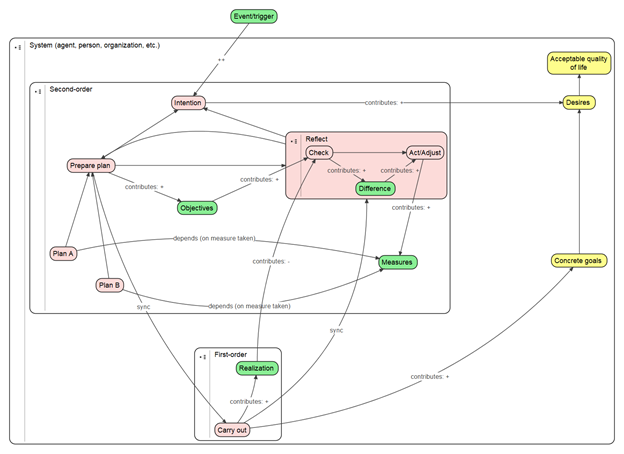LC 00570: verschil tussen versies
Geen bewerkingssamenvatting |
Geen bewerkingssamenvatting |
||
| Regel 1: | Regel 1: | ||
'''!!!''' <u>De | '''!!!''' <u>De tekst hieronder bevat veel speciale tekens die we zelf moeten gaan toevoegen (zie {{Cite|resource=Bestand:Taking History into Account symbols.pdf|name=PDF met dezelfde tekst als hieronder|dialog=process-file-dialog}}):</u> | ||
We make decisions based on past experiences, which is summarized in a LoF expression as ˌ𝑠𝑦𝑠𝑡𝑒𝑚|̅̅̅̅̅̅̅̅̅̅̅𝑒𝑛𝑣𝑖𝑟𝑜𝑛𝑚𝑒𝑛𝑡|̅̅̅̅̅̅̅̅̅̅̅̅̅̅̅̅̅̅̅̅̅̅̅̅̅̅̅̅̅̅ | |||
or in a similar vein as ˌ𝐼|̅𝑤𝑜𝑟𝑙𝑑|̅̅̅̅̅̅̅̅̅̅̅̅ | |||
The form expression is re-entered in its own indicational space in order to base a next step on past experiences. In the human cognition behavior model, this is modeled in the form of a PDCA-cycle in which the reflection activity corresponds with Check-Act/Adjust. But how precisely the past is taken into account is left implicit in the model. The precise details are usually not needed to get the message across. However, for precise modeling, e.g., for simulation purposes, the details do matter. The principles are worked out here in a rough sketch. | |||
[[Bestand:History model.png|gecentreerd|miniatuur|624x624px|Figure: history model.]] | [[Bestand:History model.png|gecentreerd|miniatuur|624x624px|Figure: history model.]] | ||
Versie van 1 dec 2020 22:16
!!! De tekst hieronder bevat veel speciale tekens die we zelf moeten gaan toevoegen (zie PDF met dezelfde tekst als hieronder):
We make decisions based on past experiences, which is summarized in a LoF expression as ˌ𝑠𝑦𝑠𝑡𝑒𝑚|̅̅̅̅̅̅̅̅̅̅̅𝑒𝑛𝑣𝑖𝑟𝑜𝑛𝑚𝑒𝑛𝑡|̅̅̅̅̅̅̅̅̅̅̅̅̅̅̅̅̅̅̅̅̅̅̅̅̅̅̅̅̅̅
or in a similar vein as ˌ𝐼|̅𝑤𝑜𝑟𝑙𝑑|̅̅̅̅̅̅̅̅̅̅̅̅
The form expression is re-entered in its own indicational space in order to base a next step on past experiences. In the human cognition behavior model, this is modeled in the form of a PDCA-cycle in which the reflection activity corresponds with Check-Act/Adjust. But how precisely the past is taken into account is left implicit in the model. The precise details are usually not needed to get the message across. However, for precise modeling, e.g., for simulation purposes, the details do matter. The principles are worked out here in a rough sketch.
The system (agent, person, organization, etc.) is split in two roles: first-order role for carrying out the work, and second-order role for planning and monitoring. The objectives and the realization thereof is checked resulting in a difference. The difference then provides the input for determining the measures to be taken. In the next planning phase, either plan A or B is chosen dependent on the measures taken. In the section on EMont executable model it is shown how the depends relation is refined to define precisely when a depends relation is satisfied or not.
So, history is taken into account by means of basing a next step on a past realization. The basic scheme can be further extended by incorporating practices and traces in the reflection activity. The reader is referred to … for an elaborated discussion.
Dit is een beveiligde pagina.
- Lees hiervoor:

